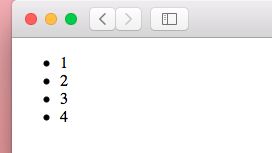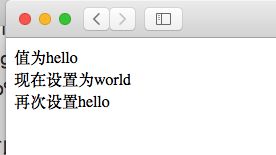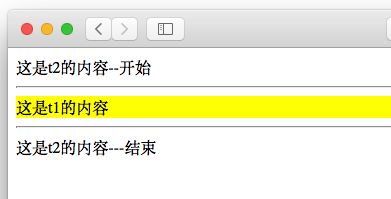1.什么是模板?
Web模板就是一些预先设计好的HTML页面,程序会通过重复的使用这些页面来创建一个或多个HTML页面。
Go语言标准库有两个模板引擎,text/template和html/template。
2.自定义模板
模板中动作默认使用两个大括号{{动作}}包围。
Go Web
{{.}}
上面编写好了模板,使用Go语言的模板引擎使用模板。.是一个动作,模板引擎执行模板时,会用一个值去替换这个动作本身。
package main
import (
"net/http"
"html/template"
"fmt"
)
func main() {
server := http.Server{
Addr: ":8080",
}
http.HandleFunc("/template", templateFunc)
server.ListenAndServe()
}
func templateFunc(w http.ResponseWriter, r *http.Request) {
t, err := template.ParseFiles("01HelloGo/src/TemplateF/tmpl.html")
if err!=nil {
fmt.Fprintln(w, err)
return
}
t.Execute(w, "hello world!")
}
使用浏览器访问可以得到如下结果:
- ParseFiles函数对模板文件进行语法分析。
- Execute执行模板函数将数据应用到模板里面。
- 如果ParseFiles没有传入文件的绝对路劲,那么,就需要把该文件放入到服务器二进制文件存放的目录中。
3.动作
3.1条件动作
{{if arg}}
some content
{{end}}
或者
{{if arg}}
some content
{{else}}
other content
{{end}}
3.2使用条件动作
定义出模板:
Go Web
{{if .}}
大于5!
{{else}}
小于5或者等于5!
{{end}}
编写出server:
package main
import (
"net/http"
"html/template"
"math/rand"
"time"
)
func main() {
server := http.Server{
Addr: ":8080",
}
http.HandleFunc("/if", ifFunc)
server.ListenAndServe()
}
func ifFunc(w http.ResponseWriter, r *http.Request) {
t, _ := template.ParseFiles("01HelloGo/src/TemplateF/IF.html")
rand.Seed(time.Now().Unix())
t.Execute(w, rand.Intn(10) > 5)
}
在上面的代码中.代表的是布尔值。
3.3迭代动作
可以对数组、切片、映射或者通道进行迭代,在迭代循环内部,.则会被设置为当前被迭代的元素。
{{range array}}
元素为{{.}}
{{end}}
模板代码:
Go Web
{{range .}}
- {{.}}
{{end}}
服务端代码:
package main
import (
"net/http"
"html/template"
)
func main() {
server := http.Server{
Addr: ":8080",
}
http.HandleFunc("/range", rangeFunc)
server.ListenAndServe()
}
func rangeFunc(w http.ResponseWriter, r *http.Request) {
t, _ := template.ParseFiles("01HelloGo/src/TemplateF/Range.html")
numbers := []int{1, 2, 3, 4}
t.Execute(w, numbers)
}
最终结果:
如果被迭代的数据为空时,可以使用如下返回一个默认值:
{{range .}}
{{.}}
{{else}}
默认值
{{end}}
3.4设置动作
允许在指定范围内为'.'设置值。
{{with arg}}
此时,.的值被设置成arg
{{end}}
编写html:
Go Web
值为{{.}}
{{with "world"}}
现在设置为{{.}}
{{end}}
再次设置{{.}}
在server中添加新的请求处理:
func withFunc(w http.ResponseWriter, r *http.Request) {
t, _ := template.ParseFiles("01HelloGo/src/TemplateF/With.html")
t.Execute(w, "hello")
}
执行结果:
设置动作也能有一个备用方案:
{{with arg}}
.被设置成arg
{{else}}
假如arg是空的,则执行备选
{{end}}
修改with.html的代码
Go Web
值为{{.}}
{{with ""}}
现在设置为{{.}}
{{else}}
由于with设置值为空,所以值依旧是{{.}}
{{end}}
再次设置{{.}}
此时再次访问:
3.5包含动作
允许在一个模板里包含另一个模板,构建出嵌套模板。
{{template "name"}}
name为包含的模板的名字
新建一个t1和t2模板:
Go Web
这是t1的内容
Go Web
这是t2的内容--开始
{{ template "T1.html"}}
这是t2的内容---结束
添加请求处理函数:
func templateFun(w http.ResponseWriter, r *http.Request) {
fmt.Println("template")
t, _ := template.ParseFiles("01HelloGo/src/TemplateF/T2.html", "01HelloGo/src/TemplateF/T1.html")
t.Execute(w, "")
}
请求结果:
可以看到,在处理函数中,我们必须将所有模板文件都进行语法分析。需要传入多个文件,其中,第一个模板文件是主模板,也就是说,主模板必须放第一个。
如果主模板要向字模板传递数据,则需要这样写:
{{template "name" arg}}
3.6变量,管道
可以在动作中设置变量:
$variable := value
也可以使用管道将多个参数、函数或者方法串联起来,将一个参数的输出传递个下一个参数,同Unix的管道:
{{p1 | p2 | p3}}
示例:
变量:
{{range $key, $value := .}}
键:{{$key}},值:{{$value}}
{{end}}
管道:
{{12.123456 | printf "%.2f"}}




